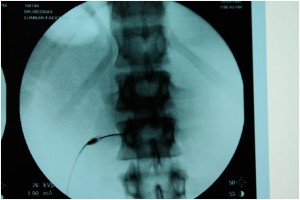Medial Branch Blocks for Facet Joint Pain
A medial branch block is the injection of numbing medication onto nerves that innervate or “supply” the facet joint (vertebra in the spine are connected to one another by facet joints, one on each side of the vertebra). This injection is administered to relieve pain in the back, thoracic back, or neck. Osteoarthritis and extension injuries are common causes of facet joint pain.
The injection typically serves 2 purposes:
- Diagnostic: to help identify the source of your pain.
- Prognostic: to help decide the next step ie. do nothing, perform a second type of injection, schedule radio frequency denervation, physical therapy, or even an evaluation by a surgeon.
The numbing medication injected blocks or numbs the nerves that carry pain sensation to the spinal cord. The procedure is performed under live x ray (fluoroscopy) and with the use of x ray dye to ensure accuracy and precision. While you are lying on your stomach, your skin is cleaned with an antiseptic solution. You are monitored with a blood pressure cuff and a blood oxygen monitoring device which monitors your oxygen levels and heart rate. The injection consists of numbing medication (lidocaine). Depending on the location one or more injections may be given. Immediately after the injection, the skin is cleaned and a band-aid is applied. If your pain is due to facet joint disease, you will experience immediate relief from pain and stiffness. Once it is determined that your pain is due to facet joint disease, we can perform a procedure called “Radio-Frequency Denervation” and prevent the conduction of pain for several months. In a way, medial branch blocks are a temporary and diagnostic procedure.
Generally speaking, the procedure is safe; however, with any procedure there are risks, side effects, and possibility of complications. The most common side effect is soreness at the injection site- which is temporary. The other risks involve bleeding and infection.

